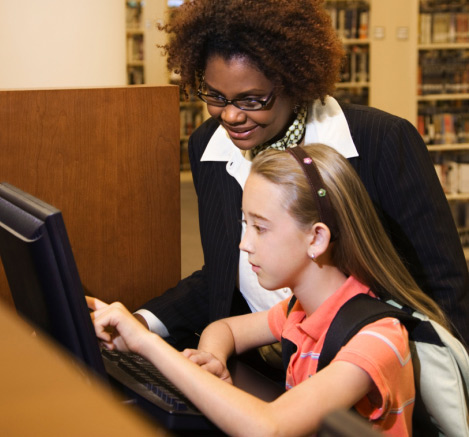CC’s Seventh Shift | On Common Core
 Librarians are often more comfortable working in the literacy classroom than manipulating mathematical data, but it may be statistics that prove to be our greatest ally. When the Common Core State Standards (CCSS) were rolled out two years ago, they were packaged as content standards, and six instructional pedagogical shifts were identified. Those shifts called for additional attention to vocabulary, nonfiction materials, text complexity, literacy across content areas, increased curriculum rigor from kindergarten through high school, and a focus on producing evidence (versus opinion). By drawing conclusions from data extrapolated from the English Language Arts (ELA) CCSS, librarians can build a strong case for a seventh shift: research.
Librarians are often more comfortable working in the literacy classroom than manipulating mathematical data, but it may be statistics that prove to be our greatest ally. When the Common Core State Standards (CCSS) were rolled out two years ago, they were packaged as content standards, and six instructional pedagogical shifts were identified. Those shifts called for additional attention to vocabulary, nonfiction materials, text complexity, literacy across content areas, increased curriculum rigor from kindergarten through high school, and a focus on producing evidence (versus opinion). By drawing conclusions from data extrapolated from the English Language Arts (ELA) CCSS, librarians can build a strong case for a seventh shift: research.
In the world of statistics, occurrence, or frequency, is often used to interpret results. Viewing the CCSS standards through a statistical lens as a body of data and assessing importance based upon word frequency produces results that support that case. Start by assuming that the ELA standards represent the intentions of the authors of the CCSS, and the objectives, learning targets, and pedagogy that they are asking educators to embrace. Investigate the language of the standards and examine the number of times certain words appear; you’ll notice that the term “research” appears 132 times, exceeding the mention of “vocabulary” (79) and “nonfiction” (64), and comes in close to “evidence” (155) and “complexity” (196). The word “information” (244) is used more often than all five, but behind “reading” (388).
Clearly, research is an essential component of the learning process in the CCSS classroom. In most schools, it’s the librarian who teaches the higher-level skills that equip students to access, evaluate, and synthesize information—information that they use to speak and write with accuracy and authority when they produce evidence and draw conclusions for discussions, debates, or written assignments.
According to the Bureau of Labor Statistics, half of this generation’s students will earn their living from the creation, dissemination, analysis, and communication of information. Under the CCSS, students begin exploring multiple points of view and presentations in the elementary years; by sixth grade, they are “researching to build and present knowledge” and by seventh grade are expected to conduct “short research projects to answer a question, drawing on several sources and generating additional related, focused questions for further research and investigation.” These benchmarks broaden and expand until 12th grade, by which time students should be “college and career ready.”
In addition, the pedagogy of evidence—text-based answers and the close reading of text—is part of the research process. Approximately half of the Common Core writing standards acknowledge that research is part of the writing process (see, Writing for Information Standards 6, 7, 8, 9, and 10). In the introduction to the ELA standards, under “Key Design Consideration” is this strong indication of that role: “To be ready for college, workforce training, and life in a technological society, students need the ability to gather, comprehend, evaluate, synthesize, and report on information and ideas, to conduct original research in order to answer questions or solve problems, and to analyze and create a high volume and extensive range of print and nonprint texts in media forms old and new….”
Perception data (the court of public opinion) can be as powerful as concrete data. It’s time for library professionals to craft a national message regarding research—in the same way that the arts have implanted themselves into the Science, Technology, Engineering, and Math (STEM) movement in education, turning it into STEAM (Science, Technology, Engineering, Math, + Art/Design). Formally acknowledging a research shift underscores its function in “building and presenting knowledge” and adds weight to the librarian’s instrumental role within the CCSS.
The time has come to raise our megaphones and strut our stuff. This is an evidence-based claim. We have the data to support it.
 Paige Jaeger (pjaeger@WSWHEBOBES.org) is coordinator for school library services, Washington Saratoga Warren Hamilton Essex BOCES, Saratoga Springs, NY.
Paige Jaeger (pjaeger@WSWHEBOBES.org) is coordinator for school library services, Washington Saratoga Warren Hamilton Essex BOCES, Saratoga Springs, NY.
RELATED
The job outlook in 2030: Librarians will be in demand
The job outlook in 2030: Librarians will be in demand
ALREADY A SUBSCRIBER? LOG IN
We are currently offering this content for free. Sign up now to activate your personal profile, where you can save articles for future viewing






Add Comment :-
Comment Policy:
Comment should not be empty !!!
Linda Aragoni
Can you provide a link to the source of this information, please: "According to the Bureau of Labor Statistics, half of this generation’s students will earn their living from the creation, dissemination, analysis, and communication of information. " Thanks.Posted : Apr 05, 2014 02:54
Toni Gredesky
Excellent article.Posted : Jan 18, 2014 01:20